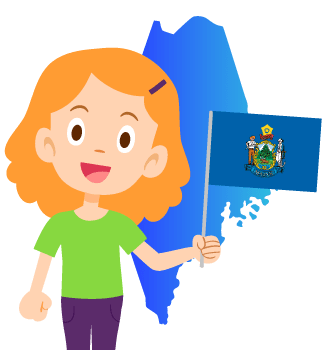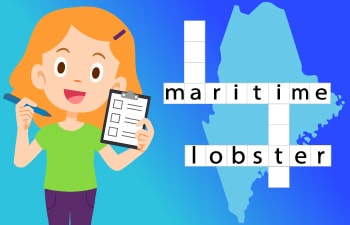Why is Maine called Maine? How and when did Maine become part of the United States? These and other questions are answered in our unit study supplement about Maine. Make sure to check out our series of unit study supplements on all 50 states!
Maine is the northernmost state of the United States. The origin of the word “Maine” is unknown as the state may have been named after an English village or French province, or it may have been derived from either of the nautical terms, “mainland” or “the main.” The origin of its nickname as the “Pine Tree State,” however, is known and is due to its white pine trees, the largest evergreens in the US.
Read the rest of this article to learn more interesting facts about Maine, including historical facts about Maine, a Maine history timeline, geography facts and more. Time4Learning members can download our list of PreK-12 interactive activities that align with your study of Maine. Here are a few Maine facts for kids:
Maine Fast Facts
|
Became a Colony: |
1652 |
|---|---|
|
Became a State: |
March 15,1820 |
|
Order it Joined the Union: |
23rd state |
|
State Capital: |
Augusta |
|
State Abbreviation: |
ME |
|
Border States: |
|
|
State Flag: |
|
|
State Song: |
|
|
State Flower: |
White Pinecone and Tassel |
|
State Nickname: |
|
|
Notable Mainers: |
|
Historical Facts About Maine
Let’s start with some historical facts about Maine. Its early people, the Abenaki and the Mi’kmaq, lived in the area 12,000 years ago, with Viking explorer Leif Ericsson possibly visiting the area in 1000 AD (this is debated). Native American tribes, including the Maliseet, Passamaquoddy, and Penobscot, then inhabited what is now Maine (with significant numbers of Passamaquoddy and Penobscot still residing in Maine today).
Early European exploration is unclear with some claims by the British in the late 1490s by John Cabot and some evidence of exploration by the Portuguese, Spanish, and French as well. The British and the French established the first settlements in Maine, with southwestern Maine forming part of the Massachusetts Bay Colony in 1652.
As part of colonial America, Maine was involved in the significant events forming our country. One year after the Boston Tea Party, Maine residents burned their own shipment of tea in opposition to Britain’s high taxes. The British responded by shelling and burning the town of Falmouth. Once the American Revolution began in 1775, Maine residents were part of the first naval battle.
Following the American Revolution, Maine joined the union as part of Massachusetts. However, many Maine residents wanted their own state, and in 1820, as part of the Missouri Compromise, Maine became the 23rd state in the US (with Maine entering as a free state and Missouri entering as a slave state).
Now read the Maine history timeline below to learn important historical facts about Maine through the events that occurred in this state.
1524
Giovanni da Verranzano explored the northeastern coast of North America, including Maine.1607
George Popham, an English settler, founded Fort St. George (the same year as Jamestown Virginia) but the settlers returned to England after just one year, leaving the title of first permanent US settlement to Jamestown1641
York became the first chartered city in America1652
Massachusetts Bay Colony annexed southwestern Maine1775
Beginning of the American Revolution, Maine gets involved in the capture of the British ship, the Margaretta1783
Peace of Paris treaty, established the northeastern boundary of Maine between the US and Britain (though later disputed further)1797
Town of Harrington changed its name to Augusta1820
Maine became the 23rd state in the US, under President James Monroe, as part of the Missouri Compromise with Portland as its capital1827
Augusta became the capital of Maine1838-1839
Aroostook War, Britain and the US fought over northeastern boundary of Maine, ending in a truce and joint occupancy of the area1842
Settlement was reached to divide the disputed territory on the northeastern border between the US and Britain1947
“The Year Maine Burned,” fires destroyed more than 200,000 acres after a long period of drought1980
US government agreed to pay Passamaquoddy and Penobscot people more than $80 million for lands taken in the 1700s1998
Ice Storm causing hundreds of millions of dollars in damages in MaineBring history and geography to life with Time4Learning’s interactive online social studies curriculum for grades 2-12.
Maine Geography Facts
Now that you have learned some interesting facts about Maine’s history, let’s examine the state’s geography. Did you know that Maine has 3,478 miles of coastline? That’s more than what California has! Did you know that the coastal islands began as mountains that went underwater as the sea rose during the last ice age? In the northwestern part of Maine are the White Mountains, part of the northern Appalachian Mountains, which include Maine’s highest point at Mount Katahdin.
Maine’s geography promotes the growth of its white pine trees, as well as black walnut trees, American elms, black oaks, and sugar maples. In fact, over eighty percent of Maine is covered in forest! Its wildflowers include the calypso orchid, Queen Anne’s lace, the Canada violet, and the mountain wood sorrel. Its state flower, the white pinecone and tassel, is actually a pinecone rather than a flower!
Maine is well known for its moose (state animal) and is also the home to bobcats, black bears, Canada lynx, and white-tailed deer. Its birds include bald and golden eagles, great gray owls, ospreys, and roseate terns. You can also find eastern garter snakes, smooth green snakes, northern redbelly snakes, eastern red-backed salamanders, bullfrogs, and eastern painted turtles. In addition to its freshwater fish, its marine life includes whales, porpoises, seals, lobsters, clams, shrimp, cod, haddock, and Atlantic salmon.
Check out this map of Maine to get the gist of the state. Then read through the following Maine geography facts. Print out the map of Maine provided below and add these features to your map.
- Maine is bordered by Canada in the north and east, the Atlantic Ocean in the south, and New Hampshire in the west.
- The capital, Augusta, lies in south-central Maine.
- The St. John River can be found in the northwest part of Maine near the border with Québec.
- The Kennebec River flows north to south through Augusta.
- The Penobscot River starts in four lakes in north-central Maine and flows into the Atlantic Ocean.
- Moosehead Lake is in the west-central part of the state on the Kennebec River.
- Mount Desert Island is the largest of Maine’s coastal islands, located near Bar Harbor.
- Maine’s highest point is Mount Katahdin at 5,267 feet above sea level, in the White Mountains, now part of Baxter State Park in the north-central part of the state.
- The lowest point in Maine is at the Atlantic Ocean, at sea level, along the southern edge of the state.
Maine State Map
Download our FREE Maine state map printable. Use it as a coloring page or use it to plot the state’s geographical features.
Activities for Children in Maine
Want to learn more fun facts about Maine? Try visiting the state to see some of its unique places. Homeschoolers in Maine can make a quick local stop or plan a day trip. Out-of-state homeschoolers can plan a longer stay. Here are a few ideas to help you learn some Maine state facts:
- Acadia National Park (Bar Harbor): Be one of the 3.5 million visitors each year but be careful to avoid the crowds. Enjoy the highest rocky cliffs of the Atlantic coastline through 27 miles of roads, 158 miles of hiking trails, and 45 miles of carriage roads. Go bicycling, birdwatching, boating, climbing, fishing, hiking, horseback riding, swimming, and tidepooling. See the beautiful colors in the fall and try skiing, snowshoeing, snowmobiling, and ice fishing in the winter. The park participates in the “Every Kid in a Park” 4th Grade Voucher Program, and several fee free days are scheduled each year. For a fun family adventure, form an Acadia Quest team prior to your visit. Whether you can visit or not, check out the free curriculum materials online.
- Baxter State Park (Millinocket): Catch sight of one of the many moose that inhabit this park and view Mt. Katahdin, Maine’s highest peak and the endpoint of the Appalachian Trail. Hike 215 miles of trails, camp at one of the 337 campsites, and explore the 209,644 acres of wilderness. Paddle, bike, climb, fish, or hunt. Bring a camera to photograph the scenery and wildlife. Non-residents must pay an entrance fee, and parking reservations are required.
- Maine Maritime Museum (Bath): Step aboard the 1906 schooner, the Mary E, and take a deck tour to hear about her history and restoration efforts. Take a guided tour of the only intact historic shipyard in the US where wooden sailing vessels were built. Visit the Donnell House, a shipyard owner’s Victorian home from 1892. Lighthouse and nature cruises are also available on the Kennebec River aboard the Merrymeeting. Watch for shipbuilding, sailing, and lobstering programs for kids. For some distance learning, access the Winds of Change resources to start conversations about cultural, political, and technological change.
- Pemaquid Point Lighthouse Park (Bristol): Open from the Middle of May to mid to late October, the park includes a learning center, art gallery, Fishermen’s Museum, and Lighthouse Tower. Visitors must be at least 46 inches tall in order to climb the tower. Enjoy local art, a video loop of Maine’s lighthouses, and the history of the fishing industry in the Bristol area. You can even rent the Lighthouse Keeper’s House Apartment and enjoy the views and passing ships for an entire week!
- Whale Watching (Various Locations): A visit to Maine wouldn’t be complete without a whale watching tour. The best times to see whales are from mid-April to October when whales come in to feast on fish, plankton, sand eels, and copepods.
Looking for more things to do with your kids in Maine? Check out this post full of field trip ideas in Maine!
Maine Freebies and Deals for Homeschoolers
Looking for ways to learn about Maine facts and information without spending a lot of cash? Below are just a few ideas:
- Children’s Museum and Theater of Maine (Portland): Discover a place that was designed for children to lead the way. Allow children to role-play in the theater spaces, imagine in the diner play area, learn in the hands-on physics area, or take on a community role in the kid-sized town. Explore exhibits featuring healthy living, fire safety, local food, car repair, lobstering, farming, and the postal system. And there is much more! On the first Friday of every month, enjoy $2 admission from 5-8 p.m.!
- Colby College Museum of Art (Waterville): Visit this museum to see over 9,000 pieces of art from various artists like Winslow Homer, John Singleton Copley, and Robert Henri. Recently added to the collection are works from Cassatt, Rembrandt, and van Gogh. Admission is free. Whether or not you can visit, take advantage of the free online educator resources.
- Moose Watching (Shirley): Bring your cameras and watch for moose in the moose wallow between Route 15 and the Maine Department of Transportation maintenance facility. You can find wallows elsewhere, but this spot has frequent sightings!
- Portland Head Light and Fort Williams Park (Cape Elizabeth): View and photograph the popular Portland Head Light landmark, the oldest lighthouse in Maine, on its spectacular shoreline complete with views of four other lighthouse towers. Visit the museum within the former keeper’s quarters that includes lighthouse lenses, artifacts, and documents. Explore Goddard Mansion (1858-59) and find the two gun batteries on the property, Battery Keyes and Battery Blair. Enjoy the beach and children’s garden. There is no admission fee (though donations are appreciated), and there is only a fee for premium parking.
- West Quoddy Head Light (Lubec): On Saturdays throughout the season, come and see some of the first rays of the sun to hit the US. Visit the site of the original tower that was built in 1808 as requested by President Thomas Jefferson and the current site of the tower built in 1858. Explore the interactive and historic displays in the Visitors Center, which is located on the first floor of the lightkeeper’s residence. Hike the trails and nature walk. Visit the bogs or the beach and maybe catch site of a whale. Although donations are appreciated, admission is free.
Maine Learning Games for Children
What interesting things about Maine did you learn? Test your knowledge of Maine facts for students with these free games and activities:













